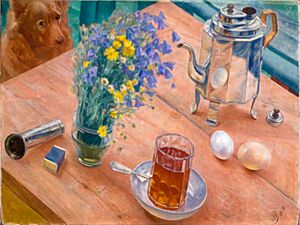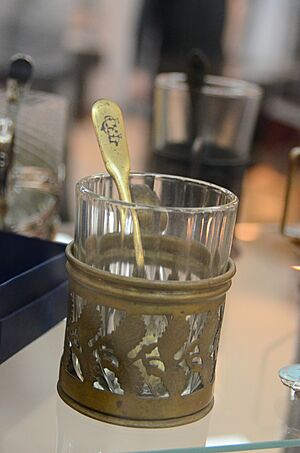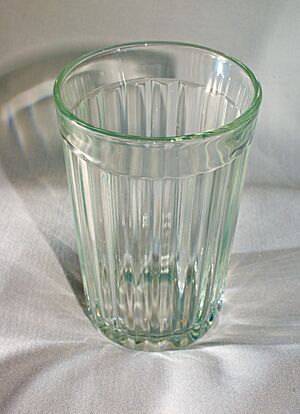Faceted glass facts for kids
A faceted glass or granyonyi stakan (Russian: гранёный стакан, which means faceted glass) is a special kind of drinking glass. It's made from very strong, thick glass and has many flat sides, called facets. This type of glass is very common in Russia and was widely used across the former Soviet Union.
Contents
The Story Behind the Faceted Glass
Early Designs and Peter the Great
The idea for the faceted glass goes way back in Russian history, even to the time of Peter the Great. He liked this design because he thought it would be less likely to roll off tables on his ships.
Legend says that a glassmaker named Yefim Smolin showed the Tsar some of these early glasses. He promised they were unbreakable! But when Peter the Great drank from one and then threw it to the ground, it broke. Even so, the Tsar was impressed and said, "Let's have that glass!" (Russian: Стакану быть!). This story might be why some people in Russia traditionally break glasses after a very important toast.
Glasses Before the Soviet Era
Before the Soviet Union, different kinds of faceted glasses were made in Russia. Some were for drinking tea, and others for champagne. Museums today have examples of these old glasses with 10, 12, or 16 sides. You can even see them in old paintings, like Morning still life by Kuzma Petrov-Vodkin, painted in 1918. These older designs were usually more cylindrical, with wider facets, and didn't have the smooth rim that later versions would.

The Soviet Faceted Glass: A New Design
The first modern Soviet faceted glass was made on September 11, 1943, at a glass factory in Gus-Khrustalny District. Many people believe the famous sculptor Vera Mukhina designed it. She was in charge of a glass workshop at the time.
This new design was made especially for Soviet canteens (like cafeterias). It had to be strong and a certain shape to work with the new dishwashing machines being used. The design added a smooth ring at the top and a solid bottom, making it very durable. Sometimes, this specific design is called the "Mukhina" tumbler.
After World War II, factories made huge numbers of these glasses – sometimes up to 600 million every year! They were used everywhere, from important government buildings to everyday places. Soviet designs had different numbers of facets, from 10 to 20, but they all had that strong, smooth rim at the top. The 16-sided glass was very common in the late 1940s and early 1950s. These glasses were made very thick, and some were even made from a special strong glass called lead glass. While they were usually very tough, some glasses made in the 1980s had problems, like cracking at the bottom. This was thought to be because of new equipment used in their production.
The Faceted Glass in Russian Life
Everyday Uses and Measurements
The faceted glass was everywhere in Soviet society. You would find them in schools, hospitals, cafeterias, and many other places. They were also super handy for cooking! Cookbooks often told people to use "numbers of glasses" instead of grams for ingredients.
A standard faceted glass could hold 250 ml (about 1 cup) if filled to the very top. If you filled it just to the smooth rim, it held 200 ml. People also used these glasses for other things, like cutting dough for dumplings (pelmeni and vareniki) or for growing small plants.

A Symbol of Russian Railways
Today, new ways of making glass mean the old Soviet design isn't as common as it once was. However, it's still very popular on Russian trains. There, you'll often see them used with a metal holder called a podstakannik for serving tea. Because of this, the faceted glass has become a symbol of Russian railways.
The glass has even been celebrated! In 2005, in a city called Izhevsk, people built a tower that was 2.5 meters (about 8 feet) tall using 2,024 faceted glasses. And now, September 11 is celebrated in Russia as "Faceted Glass Day," marking the day the first Soviet design was made.


